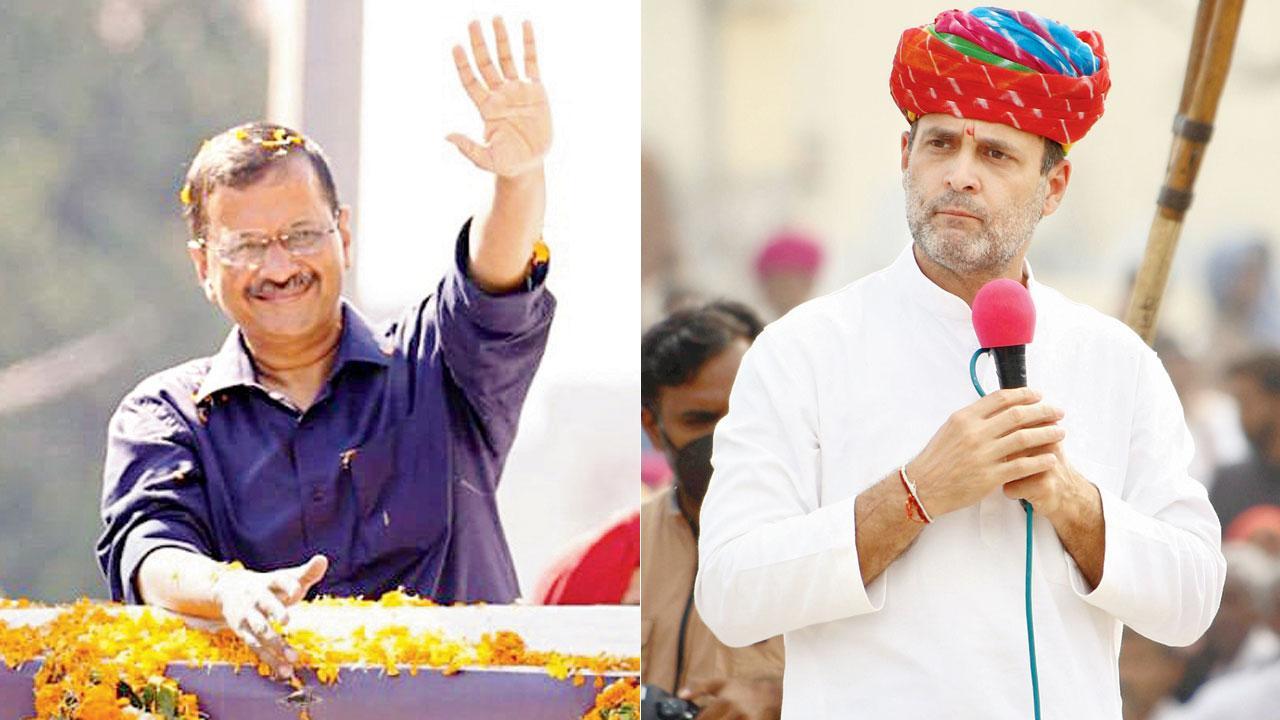Rahul Gandhi, unlike Arvind Kejriwal who led his party to victory in another state, is a brand that has failed many launches, and an elite who can’t reinvent himself and the party by launching a movement

Rahul Gandhi (right) appears to have acquired ideological clarity after 2019, in contrast to Arvind Kejriwal tilting towards the Hindu Right. Pic/ANI
 The story of the Bharatiya Janata Party’s domination of north India is now too familiar to be retold, as is the decline of the Congress countrywide. Yet the defeat of India’s grand old party in Punjab imparts a new dimension to its freefall. It was not facing a challenge from the BJP’s formidable election machinery; it was not vanquished by a regional entity boasting a long history of political participation.
The story of the Bharatiya Janata Party’s domination of north India is now too familiar to be retold, as is the decline of the Congress countrywide. Yet the defeat of India’s grand old party in Punjab imparts a new dimension to its freefall. It was not facing a challenge from the BJP’s formidable election machinery; it was not vanquished by a regional entity boasting a long history of political participation.
ADVERTISEMENT
The Congress was humiliated by the Aam Aadmi Party, which miraculously appeared, without even trying, in Punjab in 2014. Then the Punjabis were mesmerised by Arvind Kejriwal’s 49-day chief ministerial stint. In 2017, two years after sweeping Delhi, the AAP built booth committees, sent its energetic volunteers to oversee them, and crafted a compelling narrative that inscribed in many a Punjabi heart the hope for change.
The party then won just 20 out of 117 seats. Five years later, last week, the party bagged 92 seats. The Congress, over the same period, came down from 77 seats to 18 seats, with its vote share plummeting from 38.5 per cent to 23 per cent.
AAP is the first regional party to have grabbed power in another state. By contrast, the Congress had nine states under its belt in 2014, but today, it has just Chhattisgarh and Rajasthan. Yes, defections led to the Congress government collapsing in Madhya Pradesh, and also the coalition of which it was a member in Karnataka. Greed for money, lust for power and fear of raids may have made Congress MLAs switch sides.
But their defections also point to the shallowness of their ideological commitment. They are often dynasts, wealthy, and too accustomed to wielding power to live without it. Contrast this to how the BJP failed to split the AAP in 2014, in the months following Kejriwal’s resignation, ultimately leading to a mid-term Assembly election.
AAP candidates in Punjab too comprised defectors, the relatively rich and those with FIRs against them. But the party also had candidates such as the mobile repair shop owner who defeated former Chief Minister Charanjit Singh Channi, and the social worker—famous for distributing sanitary napkins to women in jails—who bested Navjot Singh Sidhu and Bikram Singh Majithia. Such candidates foster a strong identification with their party among ordinary folks.
The Congress, too, tried this strategy by appointing Channi as chief minister. But Sidhu, whose ego is typical of those who are to the manor born, turned him into a joke, which the Dalits found insulting. The promotion of Sidhu speaks poorly of the Congress leadership—Rahul and Priyanka Gandhi.
Rahul Gandhi appears to have acquired ideological clarity after 2019, in contrast to Kejriwal tilting towards the Hindu Right. This is evident from Gandhi eschewing talks such as being a janeu-wearing Brahmin, although, under pressure, he borrowed from the BJP’s playbook to accuse Kejriwal of being a terrorist. Gandhi’s tweets have been sharp, even prescient at times. Yet social media only amplifies the ground reality, which Gandhi’s Congress has been unable to alter.
This can only be done through a movement, for the Congress has waited just too long for the people to be alienated from the BJP. It is only through movements new leaders for the new age can be found. True, the Congress fielded many courageous women activists in Uttar Pradesh. But opting for them before initiating a movement is akin to putting the cart before the horse. Movements create symbols and create affinity for parties leading them. This helps build booth committees and people them with ideologically committed volunteers willing to work 365 days. But the Congress, like most opposition parties, wakes up four-five months before any election is due.
By contrast, the 2011-2012 anti-corruption movement birthed the AAP, which explains its vitality. Its government remarkably improved the health and education sectors, which define what is called the Delhi model, a promise the AAP holds out wherever it goes. Can the Congress showcase a Chhattisgarh or Rajasthan model? For sure, the AAP could build a model because it is easier to rule the city of Delhi than a predominantly rural state riven by caste complexities. Punjab will test the AAP to no end.
The Congress, unlike the AAP, has a long past, from which its rivals can selectively pick incidents to attack it. The BJP has also invested heavily in disparaging, unfairly, the Congress’s past, a task made easier as the newer generations did not witness the party’s efforts to build the nation. And, anyway, past glories cannot win the present for the party.
Defeat only begets defeat. After conquering Punjab, the AAP is mulling over its electoral prospect in Himachal Pradesh. The day after the BJP won four out of five states, Narendra Modi visited Gujarat. Both these states go to the polls this year. Rahul, by contrast, cannot go to the two states until the party’s debacle in Punjab, Uttarakhand and Goa loses its freshness in public memory.
Gandhi is a brand that has failed several launches. It is hard to conceive a fifth-generation dynast launching a sustained movement to reinvent the party—and himself. At the same time, the party fears splits without the Gandhis. What a deadly trap!
The writer is a senior journalist
Send your feedback to mailbag@mid-day.com
The views expressed in this column are the individual’s and don’t represent those of the paper
 Subscribe today by clicking the link and stay updated with the latest news!" Click here!
Subscribe today by clicking the link and stay updated with the latest news!" Click here!







